Cottonwood Heights Wellbeing Survey Findings 2022
By Dr. Courtney Flint and Team

courtney.flint@usu.edu
435-797-8635
Summary
Cottonwood Heights City is one of 33 cities participating in the Utah Wellbeing Survey Project in 2022. This project is designed to assess the wellbeing and local perspectives of city residents and to provide information to city leaders to inform their general planning process.
We are grateful to all participants who took the survey and to our city partners who helped to make this possible. Additionally, we are grateful to the Utah League of Cities and Towns and USU Extension for their financial support.
What is in this report?
This report describes findings from the 2022 Cottonwood Heights survey and some comparative information with other project cities. Feedback from city leaders, planners, and residents is welcome.
How was the survey conducted?
Starting in April of 2022, Cottonwood Heights City advertised the survey via email lists, electronic newsletters, print newsletters, and social media. All city residents age 18+ were encouraged to take the online Qualtrics survey.
How many people responded?
- 227 viable surveys were recorded in this 2022 survey effort with 90.4% complete responses.
- The adult population of Cottonwood Heights was estimated at 26,493, based on the 2016-2020 American Community Survey by the U.S. Census. The 227 survey responses in 2022 represent 0.86% of the adult population and have a conservative margin of error of 6.46%.
Key Findings
Overall Personal Wellbeing and Community Wellbeing in Cottonwood Heights were above average among the 33 study cities.
Highest Rated Wellbeing Domains:
- Living Standards
- Mental Health
- Physical Health
- Connection with Nature
Most Important Wellbeing Domains:
- Physical Health
- Safety and Security
- Mental Health
- Living Standards
Red Zone Domain: (High Importance, Lower Quality)
- Local Environmental Quality
Perception that residents take action and feelings of community connection in Cottonwood Heights were lower than in most other study communities.
Manufacturing and Extractive Industry had negative influences on wellbeing, while natural landscapes like mountains, rivers, and trails were highly positive.
The majority of respondents felt Population Growth was too fast, but they were more evenly distributed on the Pace of Economic Development between just right and too fast.
Top concerns for the future of Cottonwood Heights were:
- Air Quality (93% Moderate or Major Concern)
- Water Supply (88% Moderate or Major Concern)
- Affordable Housing (82% Moderate or Major Concern)
- Climate Change (82% Moderate or Major Concern)
- Roads and Transportation (80% Moderate or Major Concern)
What do people value most about Cottonwood Heights?
Great location, positive social climate, access to nature and surrounding natural beauty, feelings of safety, and a peaceful and quiet place to live.
Key Wellbeing Issues and Resource Areas
In addition to providing partner cities with the opportunity to take part in surveys, the Utah Wellbeing Project has worked to provide curated resources for community leaders and citizens that aim to improve specific aspects of wellbeing. These Wellbeing Resources can be found on the Utah Wellbeing Project Website, along with other useful tools and information.
Based on results of the 2022 Utah Wellbeing Project Surveys in Cottonwood Heights, key wellbeing issues include: Air Quality, Water Supply, and Affordable Housing. Below you will find links to specific wellbeing resource areas we believe may be used to target some of these issues.
Survey Respondent Characteristics
Table 1.1
| Full Time Residents of Cottonwood Heights | 96.9% |
| Part Time Residents of Cottonwood Heights | 3.1% |
| Length of Residency — Range | 0.7 - 52 years |
| Length of Residency — Average | 16.8 years |
| Length of Residency — Median | 14 years |
| Length of Residence 5 years or less | 21.6% |
Table 1.2
| Zipcodes | Percent of Respondents |
| 84121 | 93.9% |
| 84047 | 1.8% |
| 84093 | 4.4% |
Demographic characteristics of the survey respondents were compared below with U.S. Census information from the 2016-2020 American Community Survey. As the table shows, 2022 survey respondents were not fully representative of Cottonwood Heights. People age 40-49, who are female, have at least a 4-year college degree, are married, own their home, are employed, and have children under 18 in the household were particularly overrepresented. People age 18-29 were particularly underrepresented. Not all respondents provided demographic information. Weighting was not used in any of the analysis for the findings presented below.
Table 2
Demographic Characteristics of Survey Respondents and U.S. Census Data for Cottonwood Heights
Demographic Characteristics |
Cottonwood Heights Wellbeing Survey | American Community Survey 2016-2020 Estimates |
|---|---|---|
| Online 2022 227 Respondents |
||
| Age 18-29 | 3.9% | 19.1% |
| Age 30-39 | 18.9% | 18.8% |
| Age 40-49 | 28.6% | 16.8% |
| Age 50-59 | 21.8% | 16.1% |
| Age 60-69 | 18.9% | 14.4% |
| Age 70 or over | 7.8% | 14.8% |
| Adult Female | 68.0% | 51.4% |
| Adult Male | 29.1% | 48.6% |
| Adult non-conforming or non-binary |
2.9% | NA |
| No college degree | 28.4% | 48.4% |
| College degree (4-year) | 71.6% | 51.6% |
| Median household income | NA | $95,427 |
| Income under $25,000 | 2.1% | 8.9% |
| Income $25,000 to $49,999 | 5.2% | 13.4% |
| Income $50,000 to $74,999 | 8.3% | 17.5% |
| Income $75,000 to $99,999 | 16.7% | 12.0% |
| Income $100,000 to $149,999 | 31.8% | 21.3% |
| Income $150,000 or over | 35.9% | 26.9% |
| Church of Jesus Christ of Latter-day Saints | 22.8% | NA |
| Other religion | 27.2% | NA |
| Agnostic/Atheist/No religious preference | 50.0% | NA |
| Hispanic/Latino | 3.4% | 5.0% |
| White | 92.0% | 92.2% |
| Nonwhite | 8.0% | 7.8% |
| Married | 76.7% | 56.6% |
| Children under 18 in household | 42.9% | 30.6% |
| Employed | 78.2% | 68.8% |
| Out of work and looking for work | 0.5% | 2.0% |
| Other | 21.1% | 29.1% |
| Own home/Owner occupied | 87.3% | 71.8% |
| Rent home/Renter occupied/Other | 12.7% | 28.2% |
Overall Personal Wellbeing and Overall Wellbeing in Cottonwood Heights
Survey participants were asked about their overall personal wellbeing and overall community wellbeing in Cottonwood Heights. These wellbeing indicators were both measured on a 5-point scale from very poor (1) to excellent (5). The average personal wellbeing score in Cottonwood Heights was 4.19 with 84% of respondents indicating their wellbeing at a 4 or 5 on the 5-point scale. The average score for community wellbeing in Cottonwood Heights was 3.72 with 62% of respondents indicating community wellbeing at a 4 or 5 on the 5-point scale.


Overall personal wellbeing and community wellbeing were higher for those in zipcodes 84047 and 84093, but this difference was not statistically significant and only 6% of respondents were from 84047 and 84093.
Comparing Wellbeing Across Utah Cities
The Utah League of Cities and Towns classifies Cottonwood Heights as a Mid-Sized City (and we have combined these with Cities of the 1st & 2nd Class). Some cities may fit within more than one cluster.
Within the more urban city cluster, Cottonwood Heights fell above the cluster average in terms of the average overall personal wellbeing and community wellbeing scores. Cottonwood Heights was statistically significantly higher than Tooele, Logan, and Midvale in terms of overall personal wellbeing, but not significantly different from any other city in the cluster. In terms of community wellbeing, Cottonwood Heights was significantly higher than Tooele, Midvale, and Logan, but significantly lower than South Jordan and Draper. Margins of error are particularly high for Delta, Helper, Midvale, and Santaquin due to low survey response.
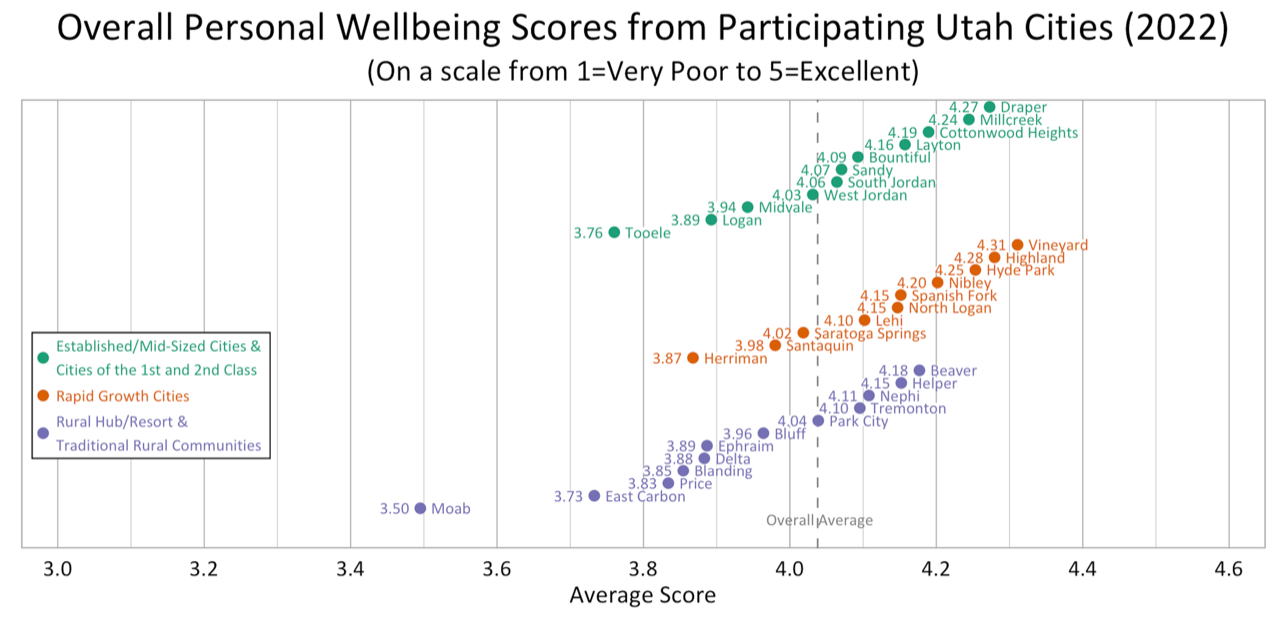
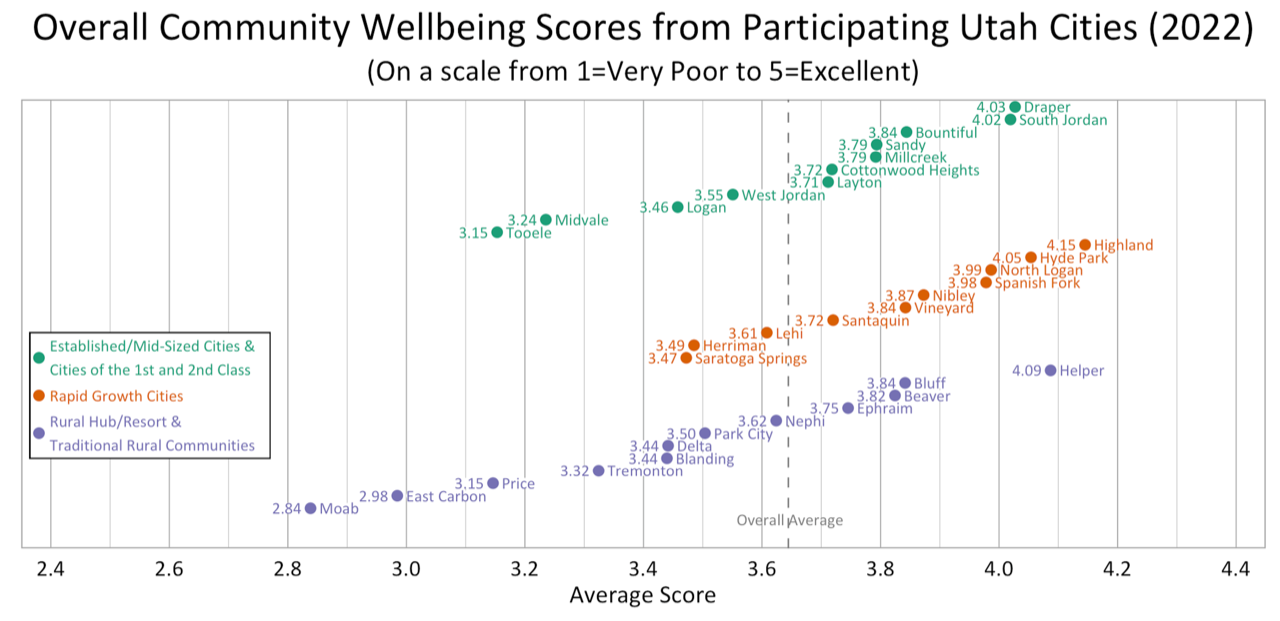
Wellbeing Domains in Cottonwood Heights
According to national and international entities that track wellbeing, there are a number of common dimensions or domains of wellbeing. In this survey, respondents rated ten domains on a 5-point scale from poor to excellent, suggesting how their wellbeing was doing in each area. They were also asked to indicate the importance of each domain to their overall personal wellbeing on a 5-point scale from not at all important to very important. The top four highest rated wellbeing domains for respondents in Cottonwood Heights were Living Standards (84%), Physical Health (82%), Mental Health (80%), and Connection with Nature (76%). The five most important wellbeing domains were Mental Health (98%), Physical Health (95%), Safety and Security (93%), Living Standards (91%), and Local Environmental Quality (91%).


Wellbeing Matrix for Cottonwood Heights
The graph below illustrates the relationship between the average rating and the average importance of wellbeing domains for survey respondents from Cottonwood Heights. Living Standards, Physical Health, Mental Health, and Safety and Security were highly important and rated above average among the domains. Local Environmental Quality fell in the “red zone” of higher importance and lower ratings, with Safety and Security approaching this zone.

How are Demographic Characteristics Related to Wellbeing?
The demographic variables for age, gender, college degree, religion, income, and length of residence were found to have varying relationships among Cottonwood Heights respondents as shown in the table below based on a generalized linear model with unweighted data. The +/- sign indicates whether the wellbeing score in the specific demographic group was significantly higher or lower than the reference group in each demographic variable (p<.05).
Table 3
Relationship Between Demographic Characteristics and Wellbeing Domains in Cottonwood Heights
| Domains Rated | Demographic Variables | |||||
|---|---|---|---|---|---|---|
| Age 60+ | Female | College Degree | Latter-day Saint | Highest Income ($150,000+) | Resident 5 Years or Less | |
| Wellbeing Ratings | ||||||
| Overall Personal Wellbeing | ||||||
| Wellbeing in Cottonwood Heights | ||||||
| Connection with Nature | + vs Other |
|||||
| Cultural Opportunities | + vs 18-39 |
|||||
| Education | + | + vs A/A/NP |
||||
| Leisure Time | + vs 18-39 |
|||||
| Living Standards | + vs Under $75,000 |
|||||
| Local Environmental Quality | ||||||
| Mental Health | + |
+ vs Under $75,000 |
||||
| Physical Health | ||||||
| Safety & Security | ||||||
| Social Connections | + vs A/A/NP |
+ vs Under $75,000 and $100,000- $149,999 |
||||
| Age 60+ | Female | College Degree | Latter-day Saint | Highest Income ($150,000+) |
Resident 5 Years or Less | |
| Domains | Domain Importance | |||||
| Connection with Nature | - vs A/A/NP |
|||||
| Cultural Opportunities | ||||||
| Education | + | + vs A/A/NP |
||||
| Leisure Time | - |
+ vs Under $75,000 |
||||
| Living Standards | ||||||
| Local Environmental Quality | - vs A/A/NP |
|||||
| Mental Health | |
|||||
| Physical Health | ||||||
| Safety and Security | + vs Under $75,000 |
|||||
| Social Connections | - | |||||
Community Action and Connection in Cottonwood Heights
Survey participants were asked about community actions and community connection in Cottonwood Heights. Both questions were scored on a 5-point scale from not at all (1) to a great deal (5). When asked about the degree to which people take action together in response to local problems or opportunities in Cottonwood Heights, the average score was 3.00. When asked about the degree they feel connected to their community, the average score was 2.86.


Latter-day Saints reported higher levels of community action than those who indicated Agnostic/Atheist/No Religious Preference and Other Religion, as well as higher perceptions of local action than those who indicated Agnostic/Atheist/No Religious Preference. Respondents age 60+ reported higher levels of community action and higher perceptions of local action than those age 18-39. Those in the highest income category ($150,000+) reported higher levels of community connection than those with household incomes under $75,000. This was based on a generalized linear model with unweighted data (p < 0.05).
Table 4
Demographic Characteristics and Community Questions
| Community Questions | Age 60+ | Female | College Degree | Latter-day Saint | Highest Income ($150,000+) | Resident 5 Years or Less |
|---|---|---|---|---|---|---|
| Do people in Cottonwood Heights take action? | + vs 18-39 |
+ vs A/A/NP |
||||
| Do you feel connected to your community? | + vs 18-39 |
+ |
+ vs Under $75,000 |
A significant, positive relationship was found between individuals’ community connection and overall personal wellbeing.

Comparing Community Action and Connection Across Cities
The graphs below show how Wellbeing Project cities compare on the degree to which people take action in response to local problems and opportunities and how connected people feel to their city as a community. Cottonwood Heights was in the lower half on perceived community action and community connection based on the number of people indicating a 4 or 5 on a 5-point scale. Margins of error are particularly high for Delta, Helper, Midvale, and Santaquin due to low survey response.
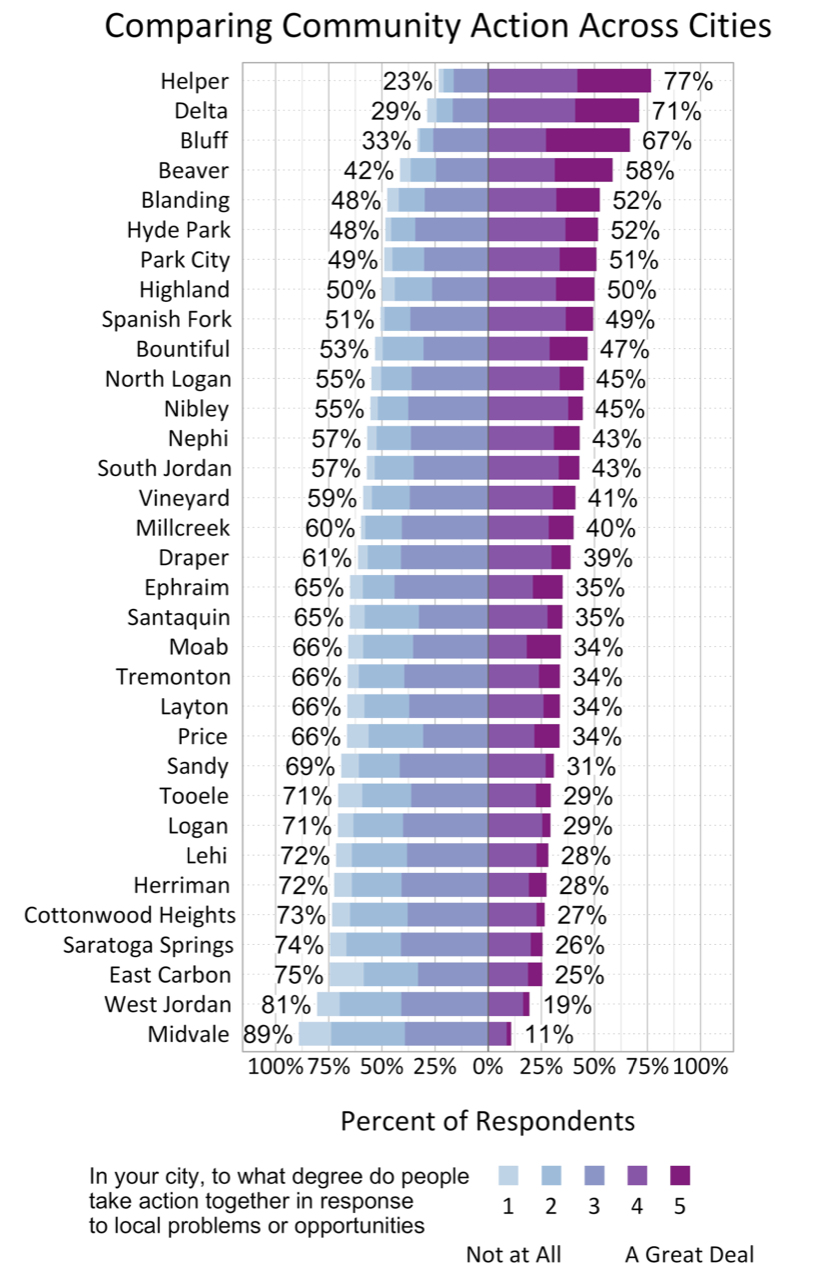
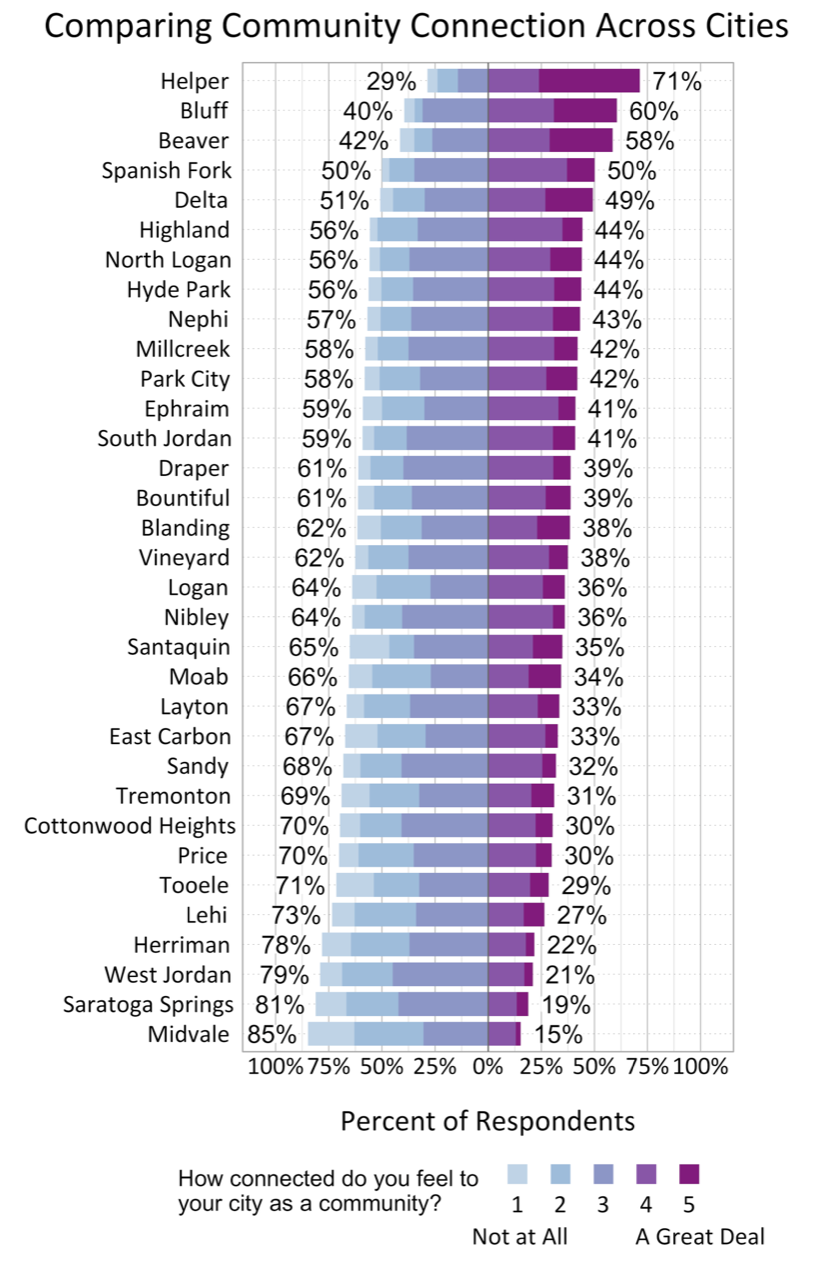
Participation in Recreation and Nature-Related Activities
Respondents were asked to indicate whether or not they participated in eight different recreation or nature-based activities in the last 12 months. Enjoying wildlife or birds in your yard or neighborhood (87%) was the most common activity for respondents, followed by gardening (86%) and recreating in parks in the city (82%).

For Cottonwood Heights respondents, none of the above recreation activities were significantly related to overall personal wellbeing or community wellbeing.
Participating in city recreation programs was positively and significantly related to community connection.
Influence of Landscape on Wellbeing
Survey participants were asked about the influence of landscape features on their wellbeing. Natural landscapes including mountains, trails, rivers and streams, and city parks were found to have an overwhelmingly positive influence on wellbeing. In terms of development and industry in the landscape, respondents were more divided. There was a particularly strong negative perception of extractive industry among Cottonwood Heights respondents.

Perspectives on Population Growth and Economic Development
The majority of respondents in Cottonwood Heights indicated that they felt population growth was too fast (60%). On the pace of economic development, 40% indicated it was too fast, 39% just right, and 11% too slow.


The graphs below show how Cottonwood Heights compares to other participating cities in the Wellbeing Project on these perceptions of population growth and economic development in 2022. Margins of error are particularly high for Delta, Helper, Midvale, and Santaquin due to low survey response.
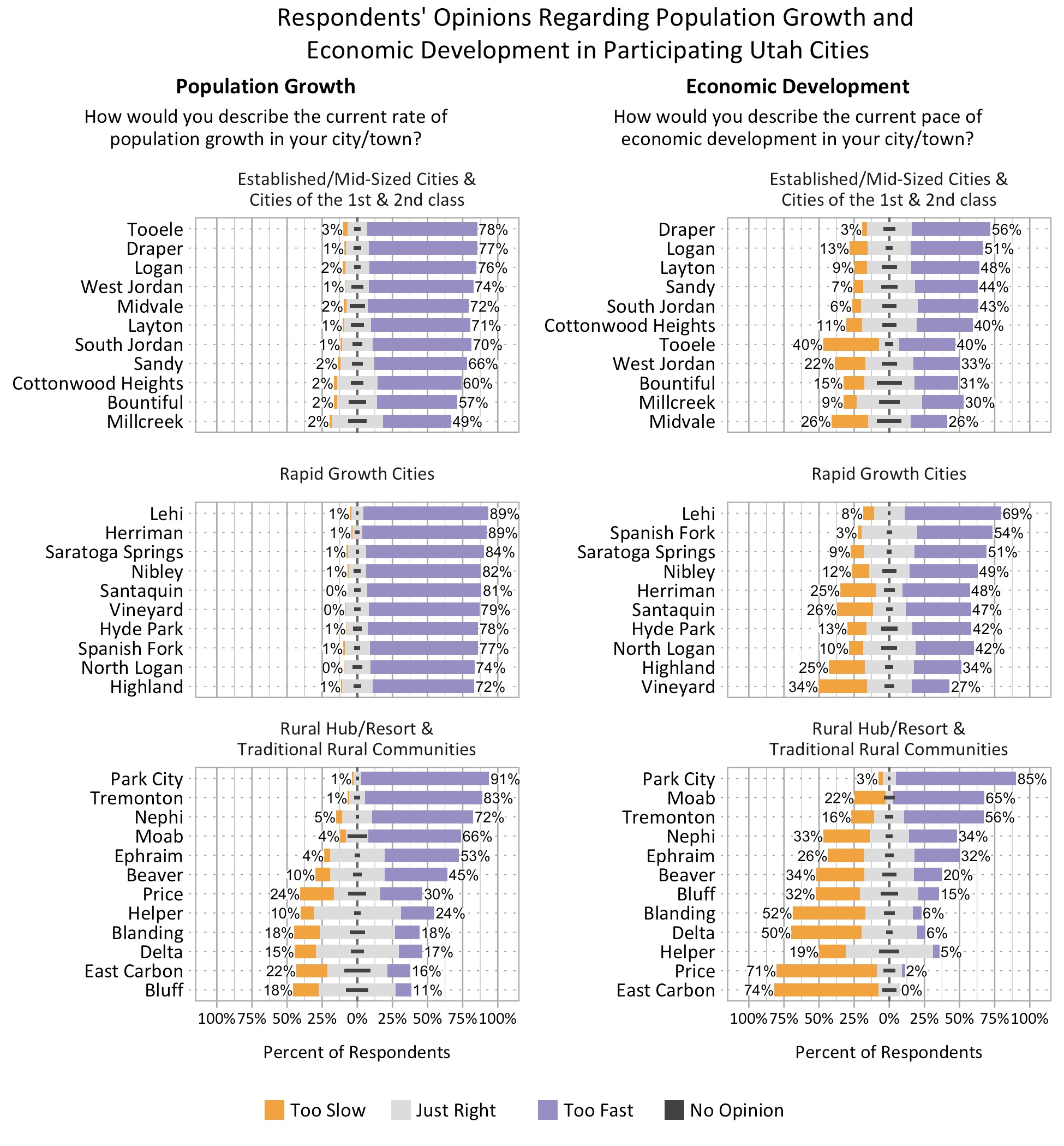
Concerns in Cottonwood Heights
Survey respondents indicated the degree to which a number of possible local issues were a concern as they look to the future of Cottonwood Heights. Air Quality, Water Supply, Affordable Housing, and Climate Change were the top four concerns with over 80% of respondents indicating these were moderate or major concerns.

Other concerns were raised by 47 respondents who filled in the “other” category. Responses identical to the categories above are not included in the table.
Table 5
Other Concerns Mentioned |
|
|---|---|
| Police (9) | Noise pollution and light pollution |
| City government and budget (6) | Prompt snow removal from roads |
| Walkability and sidewalks (5) | Corruption |
| Traffic and parking (4) | Public transportation |
| High density housing, overdevelopment (3) | Gravel pit |
| Internet (2) | Lack of green space |
| Politics (2) | Inflation |
| Gondola (2) | LGBTQ rights |
| Sustainable landscaping | Laws against short term rentals |
Open Comments
Survey respondents were asked to comment on what they value most about Cottonwood Heights and to provide any additional comments about wellbeing in Cottonwood Heights. Comments have been shared with city leaders. In summary, many people in Cottonwood Heights valued their location, specifically in relation to their proximity to canyons, nature, and recreation. The social climate was also valued by residents of Cottonwood Heights, this includes community and neighbors. Safety as well as peace and quiet were also valued in Cottonwood Heights. The additional comments section included comments about housing in Cottonwood Heights, mainly in concern to high density and multi-family housing. Transportation comments were also made, mainly concerned about the walkability in the community. Residents of Cottonwood Heights also made comments about safety, many in relation to the Cottonwood Heights police.

